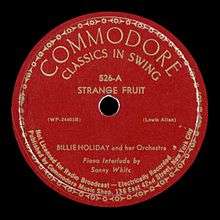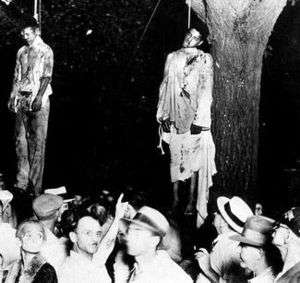Strange Fruit
| "Strange Fruit" | ||||||||||
|---|---|---|---|---|---|---|---|---|---|---|
 | ||||||||||
| Single by Billie Holiday | ||||||||||
| B-side | Fine and Mellow | |||||||||
| Released | 1939 | |||||||||
| Format | 78 rpm | |||||||||
| Recorded | April 20, 1939[1] | |||||||||
| Genre | Blues, Jazz | |||||||||
| Label | Commodore | |||||||||
| Writer(s) | Abel Meeropol | |||||||||
| Billie Holiday singles chronology | ||||||||||
| ||||||||||
"Strange Fruit" is a song performed most famously by Billie Holiday, who first sang and recorded it in 1939. Written by teacher Abel Meeropol as a poem and published in 1937, it protested American racism, particularly the lynching of African Americans. Such lynchings had reached a peak in the South at the turn of the century, but continued there and in other regions of the United States.[2][3] Meeropol set it to music and, with his wife and the singer Laura Duncan, performed it as a protest song in New York City venues in the late 1930s, including Madison Square Garden.
The song continues to be covered by numerous artists, and has inspired novels, other poems, and other creative works. In 1978, Holiday's version of the song was inducted into the Grammy Hall of Fame.[4] It was also included in the list of Songs of the Century, by the Recording Industry of America and the National Endowment for the Arts.
Poem and song

"Strange Fruit" was originated as a poem written by American writer, teacher and songwriter Abel Meeropol, a Communist, under his pseudonym Lewis Allan, as a protest against lynchings.[6][7][8] In the poem, Meeropol expressed his horror at lynchings, inspired by Lawrence Beitler's photograph of the 1930 lynching of Thomas Shipp and Abram Smith in Marion, Indiana.[7] He published the poem under the title "Bitter Fruit" in 1937 in The New York Teacher, a union magazine.[9] Though Meeropol had asked others (notably Earl Robinson) to set his poems to music, he set "Strange Fruit" to music himself. His protest song gained a certain success in and around New York. Meeropol, his wife, and black vocalist Laura Duncan performed it at Madison Square Garden.[10]
The lyrics are under copyright but have been republished in full in an academic journal, with permission.[11]
Billie Holiday's performances and recordings
Barney Josephson, the founder of Cafe Society in Greenwich Village, New York's first integrated nightclub, heard the song and introduced it to Billie Holiday. Other reports say that Robert Gordon, who was directing Billie Holiday's show at Cafe Society, heard the song at Madison Square Garden and introduced it to her.[9] Holiday first performed the song at Cafe Society in 1939. She said that singing it made her fearful of retaliation but, because its imagery reminded her of her father, she continued to sing the piece, making it a regular part of her live performances.[12] Because of the power of the song, Josephson drew up some rules: Holiday would close with it; the waiters would stop all service in advance; the room would be in darkness except for a spotlight on Holiday's face; and there would be no encore.[9] During the musical introduction, Holiday stood with her eyes closed, as if she were evoking a prayer.
Holiday approached her recording label, Columbia, about the song, but the company feared reaction by record retailers in the South, as well as negative reaction from affiliates of its co-owned radio network, CBS.[13] When Holiday's producer John Hammond also refused to record it, she turned to her friend Milt Gabler, whose Commodore label produced alternative jazz. Holiday sang "Strange Fruit" for him a cappella, and moved him to tears. Columbia gave Holiday a one-session release from her contract so she could record it; Frankie Newton's eight-piece Cafe Society Band was used for the session. Because Gabler worried the song was too short, he asked pianist Sonny White to improvise an introduction. On the recording, Holiday starts singing after 70 seconds.[9] Gabler worked out a special arrangement with Vocalion Records to record and distribute the song.[14]
Holiday recorded two major sessions of the song at Commodore, one in 1939 and one in 1944. The song was highly regarded; the 1939 recording eventually sold a million copies,[7] in time becoming Holiday's biggest-selling recording.
In her autobiography, Lady Sings the Blues, Holiday suggested that she, together with Meeropol, her accompanist Sonny White, and arranger Danny Mendelsohn, set the poem to music. The writers David Margolick and Hilton Als dismissed that claim in their work Strange Fruit: The Biography of a Song, writing that hers was "an account that may set a record for most misinformation per column inch". When challenged, Holiday—whose autobiography had been ghostwritten by William Dufty —claimed, "I ain't never read that book."[15]
Influence
In October 1939, Samuel Grafton of The New York Post described "Strange Fruit": "If the anger of the exploited ever mounts high enough in the South, it now has its Marseillaise."[16]
Honors
- 1999: Time magazine named Strange Fruit as "Best Song of the Century" in its issue dated December 31, 1999.[17][18]
- 2002: The Library of Congress honored the song as one of 50 recordings chosen that year to add to the National Recording Registry.
- Serbian rock musician, journalist and writer Dejan Cukić wrote about "Strange Fruit" as among 45 songs that changed the history of popular music in his book 45 obrtaja: Priče o pesmama (2007).
- 2010: The New Statesman listed it as one of the “Top 20 Political Songs”.[19]
- The Atlanta Journal-Constitution listed the song as Number One on "100 Songs of the South".[20]
In popular culture
Comics
- Alan Moore, Stephen Bissette and John Totleben's comic book Swamp Thing #42 (1985) features a story titled "Strange Fruit" for a horror story about southern racism.
- Mark Waid and artist J. G. Jones produced a comic book dealing with themes of racism and civil rights, entitled Strange Fruit for Boom! Studios.[21]
Film
- Bob Dylan cited "Strange Fruit" as an influence in the documentary No Direction Home (2005)
Literature
- Lillian Smith's novel Strange Fruit (1944) was said to have been inspired by Holiday's version of the song.[22]
Television
- American Dad! Season 9, Episode 10 ("Blood Crieth Unto Heaven") uses a clip in the opening act.
- Katey Sagal with The Forest Rangers and Blake Mills's cover was used in the Sons of Anarchy episode, "Fruit for the Crows" (2011), in which a club member tries to hang himself.[23]
- Season 1 Episode 2 of The Man in the High Castle depicts a vinyl record playing the song.[24]
- Billie Holiday's battle with drugs and her first time singing "Strange Fruit" are explored in Season 7, Episode 149 of Touched by an Angel ("God Bless The Child").
- Criminal Minds: The season nine episode of the same name deals with racism and hate crimes which pays a homage to the original song.
Cuisine
- The Cambridge, Massachusetts restaurant The Friendly Toast included a drink called Strange Fruit, after Smith's novel, on a menu of cocktails named after banned books. In 2015 this generated controversy, as a patron took the name as a reference to the song and found it inappropriate. The drink was later removed from the menu.[25][26]
Bibliography
- Clarke, Donald (1995). Billie Holiday. Wishing on the Moon. München: Piper. ISBN 3-492-03756-9.
- Davis, Angela (1999). Blues Legacies and Black Feminism. Diverse Ausgaben, z. B. Vintage Books. ISBN 0-679-77126-3.
- Holiday, Billie & Dufty, William (with) (1992). Lady Sings the Blues (autobiography). Edition Nautilus. ISBN 3-89401-110-6.
- Margolick, David & Als, Hilton (2000). Strange Fruit. Billie Holiday, Café Society and an Early Cry for Civil Rights (Hardcover ed.). Running Press. ISBN 0-7624-0677-1.
- Margolick, David, & Als, Hilton (2001). Strange Fruit. The Biography of a Song (Paperback ed.). Ecco. ISBN 0-06-095956-8.
References
- ↑ "Billie Holiday recording sessions". Billieholidaysongs.com. Retrieved April 20, 2011.
- ↑ "Lynching Statistics for 1882-1968". Chesnuttarchive.org. Retrieved July 21, 2013.
- ↑ "War and Social Upheaval: the American Civil Rights Movement - lynching". Histclo.com. Retrieved July 21, 2013.
- ↑ "Hall of Fame". Retrieved June 16, 2015.
- ↑ "Strange Fruit: Anniversary Of A Lynching". NPR. August 6, 2010. Retrieved August 15, 2013.
- ↑ Margolick, David (2000). Strange Fruit: Billie Holiday, Café Society, and an Early Cry for Civil Rights. Philadelphia: Running Press. pp. 25–27.
- 1 2 3 Moore, Edwin (September 18, 2010). "Strange Fruit is still a song for today | Index Strange Fruit is still a song for today". The Guardian. Retrieved September 23, 2010.
- ↑ Blair, Elizabeth (Host) (September 5, 2012). "The Strange Story Of The Man Behind 'Strange Fruit'". Morning Edition. NPR.
- 1 2 3 4 Lynskey, Dorian (2011). "33 Revolutions Per Minute". London: Faber & Faber. ISBN 0-571-24134-4.
- ↑ Margolick, Strange Fruit, pp. 36–37.
- ↑ Meeropol, Abel (12 July 2006). "Strange fruit" (PDF). International Journal of Epidemiology. 35 (4): 902–902. doi:10.1093/ije/dyl173. Retrieved January 6, 2013.
- ↑ Margolick, Strange Fruit, pp. 40–46.
- ↑ Margolick, Strange Fruit, pp. 61-62.
- ↑ Billy Crystal, 700 Sundays, pp. 46–47.
- ↑ Margolick, Strange Fruit, pp. 31-32.
- ↑ Lynskey, Dorian (February 15, 2011). "Strange Fruit: the first great protest song". The Guardian.
- ↑ Billy Crystal, 700 Sundays, p. 47.
- ↑ McNally, Owen (March 30, 2000). "'Song of the century' chilling: Graphic lyrics of 'the first unmuted cry against racism' are making a comeback". Ottawa Citizen.
- ↑ Smith, Ian K (March 25, 2010). "Top 20 Political Songs: Strange Fruit". New Statesman. Retrieved March 25, 2010.
- ↑ "100 Songs of the South | accessAtlanta.com". Alt.coxnewsweb.com. Retrieved April 20, 2011.
- ↑ Towers, Andrea (June 30, 2015). "Mark Waid and J.G. Jones preview powerful historically based comic, Strange Fruit". Entertainment Weekly. Archived from the original on September 5, 2015.
- ↑ Bass, Erin Z. (December 12, 2012). "The Strange Life of Strange Fruit". Deep South Magazine.
- ↑ "Sons of Anarchy (TV Series) : Fruit for the Crows (2011) : Soundtracks". IMDb.com. Retrieved August 6, 2014.
- ↑ ""The Man in the High Castle" Sunrise (TV Episode 2015) - Soundtracks - IMDb". Retrieved 2015-11-09.
- ↑ "Friendly Toast pulls a drink called 'Strange Fruit' off its menu".
- ↑ "Restaurant Learns the Hard Way Why You Never Name a Cocktail 'Strange Fruit'".
External links
- "Strange Fruit", Independent Lens, PBS
- Strange Fruit, Newsreel documentary
- "Strange Fruit", Shmoop, analysis of lyrics, historical and literary allusions - student & teaching guide
- Lyrics of this song at MetroLyrics
- "Strange Fruit" at MusicBrainz (information & list of recordings)
- BBC Radio 4 - Soul Music, Series 17, Strange Fruit
- "Strange Fruit: A protest song with enduring relevance"
- "Strange Fruit". Radio Diaries (Podcast). PRX. Retrieved 2015-09-04.
